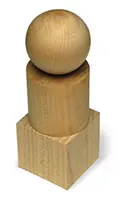Intro to the Froebel Gifts
The Froebel® Gifts are educational materials developed for Friedrich Froebel’s original Kindergarten. Perhaps the world’s most intricately conceived playthings, these materials appear deceptively simple, but represent a sophisticated approach to child development. The Gifts are arguably the first educational toys.
Froebel developed special educational toys for his Kindergarten schools. They were so named because they were both given the the child (to be properly respected as gifts) and also function as tools for adults to observe the innate human “gifts” each child posseses from birth. One observes the remarkable qualities and innovative ideas that make each child unique when they have the opportunity to explore and create according to Froebel’s method. The materials are known in a variety of terms, including Eunmul (South Korea), Gabe (Asia) and Spielgabe (Germany).
The materials were not some accidental creation, as some modern historians assume. Froebel spent a great deal of time observing children and refining the design of the Gifts. He numbered Gifts 1-6 (the only materials to identified specifically as “Gifts” in Froebel’s writing) in part because it simplifies referring to them. Later materials can be described succinctly as tablets (Gift 7), sticks (Gift 8), rings (Gift 8 or 9), points (Gift 9 or 10). For example, Gift 2 is a set of wood solids (sphere, cylinder, cube) with a hanging apparatus. Eight one-inch wood cubes is known more simply as Gift 3, etc.
Gifts have one primary difference from other materials used in the Kindergarten — they are able to be returned to their original form when play is finished. An important part of Gift play, the presentation of the Gift is always as a whole form (e.g. Gift 3 removed from the box as a cube form of 8 cubes), and when play is done parts are combined before being placed into the box as a whole. There are only two other rules for Gift play; (1) all parts must be incorporated and (2) a creation is always changed through modification, not destoyed and rebuilt. In this way unity is maintained and subtle lessons about the nature of change are learned.
For video training on using the Froebel® Gifts visit this FroebelUSA.com

